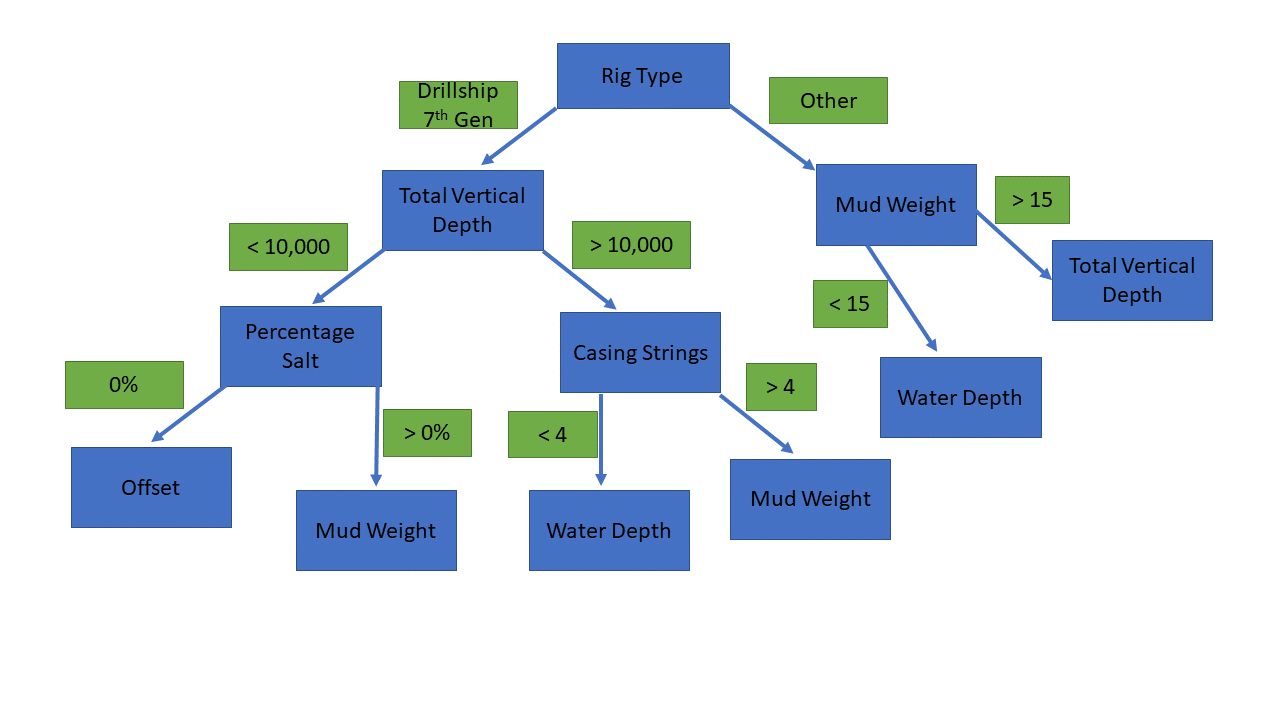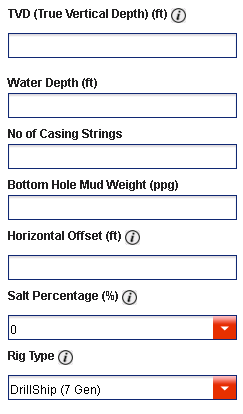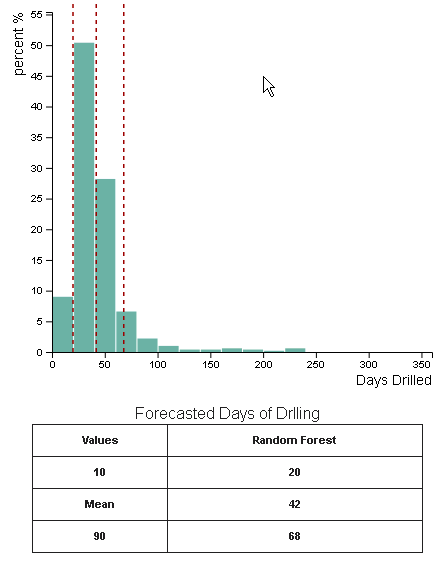Drilling Forecast
Overview
The drilling forecast takes user provided input parameters and makes a forecast on the number of days the project will take to complete.
Prediction Model
Two random forest models were made using data from drilling projects since 2002. One model uses the percentage drilled through salt as a variable while the other does not.
A total of 500 trees were used in the random forest with a minimum of 5 projects in each node.
Input
The user provided input and the variables are used to train the model. The report generates a pdf with a little more information.
Output
The primary output is the forecasted drill time and the 10/90 prediction interval.
Overview
The drilling forecast takes user provided input parameters and makes a forecast on the number of days the project will take to complete. The data is trained on over 2,900 well projects. A well project consist of the primary well drilled through the mudline and all bypasses. Sidetrack projects were not included in this training set and new models may be created in the future for sidetracks but currently this forecast will not be accurate for sidetracks.
Prediction Model
Two random forest models were made using data from drilling projects since 2002. One random forest model uses the percentage drilled through salt as a variable while the other does not. This was done since several projects did not have sufficient data to determine the presence of salt.
A total of 500 trees were used in the random forest with a minimum of 5 projects in each node.
The model predicts drill time in days. The drill time is the days from spud to the time it took to reach total depth. Any non-productive time is included as this is the amount of real time it took to complete the project. In some cases, the project is taken offline for an extended period. When these cases are identified this offline time is not counted in the total drill time as this appears to be related to extreme events. The model was also limited to projects that took between 5 and 365 days to complete since projects outside this range were outliers or possibly bad data.

Input
The user provided input and the variables used to train the model are total vertical depth, water depth, number of casing strings, bottom hole mud weight, offset distance, rig type, percentage drilling through salt. Note that two of the inputs are transformed before being used by the model. The model uses TVD below the mudline as opposed to below mean sea level and the offset is converted into an angle measuring the deviation from the surface location to the bottom hole location. Using the TVD below mudline and the angle produced more accurate results so these are used internally.
The rig type is one of: Jackup, Semisubmersible, DP Semisubmersible, Platform, Drillship, or Drillship 7th Generation. The 7th generation drillship has its own category since they were shown to be significantly faster than other generations of drillships.
Percentage drilled through salt is optional and if you do not wish to specify it select "Unknown". If "Unknown" is selected, the random forest that does not use salt will be used to create the forecast.

Output
The primary output is the forecasted drill time and the 10/90 prediction interval. The forecast is the mean of the 500 terminal nodes reached given the input parameters and the 10/90 prediction interval is the 10th/90th percentile respectively of the 500 terminal nodes. The web page displays a histogram of the days drilled for each of the 500 trees.
The report generates a pdf with a little more information. The report contains the input parameters, the forecast, some information on accuracy, and the partial dependence plots of the input variables. The input parameters also list the average rate of change of the drill time with that input. This is derived from the partial dependence plots. The accuracy information is a plot of the predicted value versus the observed value. If the forecast was perfect, all points would fall on the red line. Points below the red line indicate the predicted drill time is less than what actually happened. Additionally, there is a map showing the spatial distribution of the percent error. The report ends with the full partial dependence plots which show how the predicted days drilled changes at all the variable levels averaging out the effects of the other variables.
Finally, an interactive map is available to show the wells with that are most analogous to the input parameters (technically, those that appear most often in the output of the random forest model). For more specific matches, please see the Analog Map section of the Drilling Analytics.


